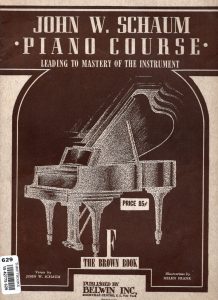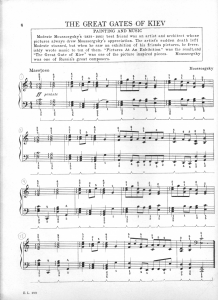 The 2022 Russian invasion of Ukraine and siege of its Capitol, Kiev made me remember having played a piece, “The Great Gates of Kiev” by Modest Mussorgsky during the early years of my piano study. After rummaging through my music library, I could not find John Schaum’s “Brown Book” (Vol. F) in which the arrangement resides. I ordered the Brown Book online.
The 2022 Russian invasion of Ukraine and siege of its Capitol, Kiev made me remember having played a piece, “The Great Gates of Kiev” by Modest Mussorgsky during the early years of my piano study. After rummaging through my music library, I could not find John Schaum’s “Brown Book” (Vol. F) in which the arrangement resides. I ordered the Brown Book online.
When I played “The Great Gates of Kiev” from “The Brown Book” as a child, I imagined grand portals opening to expose a splendid, shining city that was pronounced with two syllables rather than with only one, as is customary today. During my research for this post, I discovered that the gate portrayed in Hartmann’s painting was not the historic Grand Golden Gate that was largely in ruins by the 17th Century.

Mussorgsky composed Pictures At An Exhibition (1874) in response to a series of paintings by his friend, then-contemporary architect and painter, Viktor Hartmann (1834–1873). Mussorgsky’s original suite of compositions were written for solo piano. The best-known derivative orchestral arrangement was one by Maurice Ravel (1875-1937). I have a particular fondness for Emerson, Lake & Palmer’s version (1971).
Hartmann’s painting was his personal, proposed project that was to be called the “Heroes’ Gates” (“Bogatyr Gates”). Though his gates were formally proposed, they were never built. The historic “Golden Gate of Kiev” remained in ruins until the 1970’s when formal restoration began and reached some stage of completion in 1983 with the opening of its associated museum.
My recording of John Schaum’s arrangement from the “Brown Book”
that I played as a child.
While searching, I found numerous arrangements and editions of this piece online at IMSLP (Petrucci Music Library). The piano-solo version I rehearsed and perform here is the original edition that was later revised and edited several times by persons other than the composer.
I have worked sporadically on this project since the Spring, 2022 Russian invasion of Ukraine. During this project, I experimented with selecting and then using different video “generators” that I attempted to aesthetically “match” to different sections of the piece. To render this, multiple recording passes were required, each pass producing a unique video from the audio. I then created titles and credits and concatenated the them using Fotomagico to create the final video.
I am attempting to avoid an overly detailed description of the multiple technical obstacles I overcame and the lessons I learned. Audio and video transitions between multiple videos was the most difficult aspect for me and is a skill on which I am still working to improve.
The virtual (software) piano I played is Synthogy Ivory’s 10′ Italian Grand using a medium-resonant soundboard model. I individually generated each video using the audio software, Project Milk Syphon and selected visualization description-files (.milk) from a trove I have collected over time. These visualizations are a current incarnation of leftovers from the ancient Winamp visualizer that was ubiquitous at one time. The generated video, synchronized with its audio was then recorded using Siphon Recorder.
Because of a problem in which the resultant audio was being damaged during output, for each video, I was later forced to replace its audio with a different version that was pristine and that had not been damaged during previous processing. Involved with accomplishing this were issues necessary to maintain synchronization between the video and audio. Needless to say, it is imperative that the audio and video line-up perfectly or it is obvious to the listener/viewer. For this, extensive use of the Terminal command: ffmpeg was required.


Leave a Reply